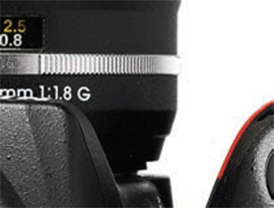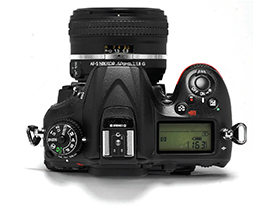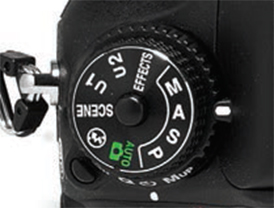 The mode dial and drive
The mode dial and drive
mode dial have locks
that prevent accidental
operation
The D7100 and 7200
are only Nikon DX
format cameras that
accept non-AF-S lenses
Ergonomics
The Nikon D7200 carries the Nikon signature of handling. The deep rubberised grip makes it very comfortable to hold. The drive mode dial has a lock to prevent accidental change in settings. The LiveView toggle switch is towards the base of the camera and easily accessible with the right hand thumb. The command dials are still placed at their positions on Nikon’s first D-SLR, a feature that is much popular with Nikon fans. Images appeared crisp on the LCD.
Performance
The Nikon D7200 performed very well in our tests. We tested the body with an AF-S Nikkor 50mm f/1.8G lens that we used with the D5500. Both Vignette Control and High ISO Noise Reduction were kept at ‘Normal’ and Long Exposure Noise Reduction was kept ‘Off’.
Autofocus was fast and precise. It could lock on to the subject even in substantially low light, thanks to the improved AF module. The metering system did the job very well. Videos were smooth. Slight darkening of corners was observed with the 50mm lens, but you might not be able to spot this in normal images.
The lens produced prominent flare along with heavy purple fringing at the wide-angle end with the lens wide open. Images appeared sharp out of the box. The sweet spot was found to be f/8. We also found f/5.6 and f/11 to be reasonably sharp. We did not observe any distortion in the lens. In fact, the optical parameters were identical to the results obtained in our D5500 tests, since these factors are determined largely by the lens used.
The D7200 reproduced colours true to the original. Auto White Balance provided consistently good results without any cast. If you use pre-set White Balance, it would be wise to fine-tune each of them according to your most used lighting conditions or remove the colour cast during post-processing.
Value for Money
The D7200 retails along with the AF-S Nikkor 18-140mm VR kit lens at Rs.104,950. The body carries a price tag of Rs.86,450. This is approximately Rs.30,000 more than the D5500.
So what makes the 7200 this expensive? The main advantages of the 7200 over the 5500 are: a weather-sealed magnesium alloy body, 50 autofocus points against 39 on the 5500, a bright pentaprism viewfinder instead of a penta mirror, maximum shutter speed of 1/8000 sec over the 5500’s 1/4000 sec., dual memory card slots, a higher X-sync speed, a slightly faster continuous shooting speed, a faster AF system that can focus in very low light, and a few cosmetic improvements. But the 7200 does not have a fully articulated LCD, which the 5500 has. So comparing these, we feel the price is quite justified for those who need these features. |SP I
FINAL SCORE 83%
Design and Build Quality 18/20
Key Features 17/20
Ergonomics 16/20
Performance
Autofocus 4.5/5
Metering 4/5
Noise Control 4.5/5
Sharpness 4/5
LCD/EVF 4/5
Auto WB 4/5
Sub-Total 25/30
Value for Money 7/10
PLUS
• Fast and sensitive AF
• Weather sealing
• Dual card slots
• Excellent noise control
• Larger buffer
• Wi-Fi and NFC enabled
MINUS
• No articulated Screen
VERDICT
The D7200 is Nikon’s replacement to the D7100, which served their customers quite well in the cropped sensor category. The new camera certainly improves on the capability of the D7100 with built-in Wi-Fi, faster and more sensitive AF module, and a few other useful features.
Sujith Gopinath



